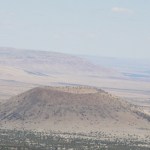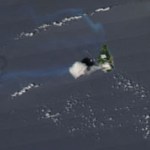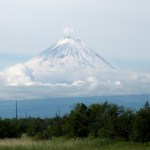remote sensing
This week's USGS/Smithsonian GVP Volcano Update!
Highlights include:
A volcano I had never heard of in the Kuril islands is showing signs of life: Kharimkotan. Satellite images show a thermal anomaly at the summit of the volcano - its last known eruption was in 1933.
Ash, sulfur dioxide and steam continue to erupt from Nyamuragira in the Congo, although lava flows have abated.
Crater C at Arenal had sporadic strombolian activity - which is par for the course for the Costa Rican volcano.
I must have missed this, but since December 14, the ash erupted at Gaua in Vanuatu has become denser and…
Somehow I haven't posted a bunch of interesting items collected over the last few weeks, so I need to catch up. A pre-emptive hat tip to everyone who has sent me links or notes that might seem familiar in this post.
Tungurahua in Ecuador erupting in 2000.
First off, those of you looking for information on the Haitian earthquake that devastated the capitol Port Au Prince, Highly Allochthonous has post on the tectonics of the quake. Right now, it is hard for me to come up with a worse location in terms of devastation for a quake to have hit in the Caribbean Basin.
Back in volcano news, a lot…
Well, this MVP was a bit trickier than most, thanks to the fact that most scoria/cinder cones look pretty similar and some initial confusion about the photo in the first place. Anyway, lets review!
The photo:
It was identified by the sender as Missouri Bill Hill in Arizona. However, this doesn't seem to be the case.
From Google Earth, Missouri Bill Hill:
After close examination by me and all of you, it seems that the consensus is that it is, in fact, Antelope Hill in Arizona - both near each other in the same volcanic field.
From Google Earth, Antelope Hill:
This leaves me confident that…
Maybe I should just apologize right here and now for that title, but dang, I liked it.
Anyway, I've seen a lot of plume images cross my browser/inbox over the last day, so I thought I'd post a few of them.
Soufriere Hills, Montserrat
The renewed activity at Soufriere Hills has produced a bounty of plume images over the last week. The NASA Earth Observatory posted an image of the plume, which sometimes reached as high as 3.7 km / 12,000 feet (if not higher). Eruptions reader Alex Waning sent me some images of the top of the plume at ~3.7 km / 12,000 feet taken from a flight near Montserrat on…
Its already Friday!
News!
Print of the Temple of Jupiter at Pompeii with a steaming Vesuvius in the background.
You can now wander down the streets of ancient Pompeii from the comfort of your own home or office. Google Streetview now cover the streets of the city wiped out by the 79 A.D. eruption of Vesuvius in Italy. Now, some of the articles on the Pompeii streetview give lipservice to the current threat of Vesuvius to the modern city of Naples, my favorite being:
The authorities continually monitor Vesuvius these days, and estimate they'll be able to give adequate warning if it's ever in…
Back to work after Thanksgiving Break ... lets clean up a few news items I missed trying to figure out the non-eruption of Karkar.
Undated photo of the summit area of Gaua, Vanuatu.
There was an actual eruption - or, more correctly, a continued eruption - of Gaua in Vanuatu. The current activity has prompted the evacuation of 300 villagers from the island and they will not be able to return until activity wanes. Tourists were also told to stay away from the volcano, but the airport on the island has not been affected by the eruption, which might suggest the activity is relatively localized…
Last week, I reported that Karkar in Papua New Guinea had erupted. This was based on reports from Volcano Live and from the Darwin VAAC that said the volcano had produced at least 1, maybe 2, ~13 km / 45,000 foot ash columns. That is not a trivial ash column - you would think a large eruption was needed to produce such an ash column (and you'd be right).
Then, no news. Nothing. I (and other Eruptions readers) scoured the web for more information on this phantom eruption at Karkar. Not a peep on noise about any eruption, let alone an eruption to send ash above 40,000 feet.
Recent reports from…
The latest news from the USGS/Smithsonian Global Volcanism Program Weekly Volcano Report ...
Highlights (not including Mayon) include:
Strombolian eruptions and small pyroclastic falls at Arenal in Costa Rica.
3 km / 10 000 foot ash plume from Bagana on Bougainville Island in Papua New Guinea.
Rumbling noises, ~4.5 km / 14 000 foot ash plumes and incandescence were all reported coming from Fuego in Guatemala.
Steam-and-ash from Popocatepetl near Mexico City reached 7.4 km / 24 300 feet.
Satellite images of Shiveluch revealed a large thermal anomaly - the new lava dome - along with multiple…
The latest of volcano news from around the world, brought to you by the USGS and Smithsonian Institute Global Volcanism Program (and especially Sally Kuhn Sennert!)
Highlights this week include:
Karangetang in Indonesia produced a couple 3 km/10,000 foot steam-and-ash plumes according to reports from pilots.
Soufriere Hills on the island on Montserrat has had quite a few pyroclastic flows over the last few weeks since the volcano started erupting again. Mix that with some heavy rainfall and lahars were produced as well.
The alert level is still at Orange at Karymsky in Kamchatka, which…
There have been a number of articles floating around the popular press for the last week that I thought I would touch on briefly ... always fun to decipher the real news from the hype.
Active fumaroles on Datun Mountain in Taipei.
An article out of the Taipei Times suggests that the city of Taipei in Taiwan is in great peril from Datun Mountain/volcano. The volcano, which was previously thought to have erupted ~200,000 years ago is now thought to have erupted only 5,000 years ago. That 195,000 years really does make a difference in terms of worrying about potential future eruptions, but…
I'll be giving a talk this afternoon here at Denison on rhyolite generation, so I might be a little brief this morning.
Undated image of Mayon in the Philippines.
The province of Albay in the Philippines is on alert for both a typhoon and a volcano (that country seems to be hit with that 300,000 may need to be ready to evacuate if the volcano continues to show signs that it might erupt - in fact, Mayon is producing ash as of this morning, albeit only one minor ash explosion.
Lava flows from Kilauea are drawing crowds as they inundate a road in Kalapana. There is a nice video link to the…
Sometimes it is hard to keep up with the mountain of remote sensing (or not so remote) images that get released on the internet. Over the last few days, the NASA Earth Observatory has released a bunch of images/videos of current eruptions, so I thought I'd round them all up here for you to peruse.
Soufriere Hills releasing puffs of ash-and-steam on October 6, 2009. Image courtesy of the NASA Earth Observatory.
Four new images in the recent past:
A nice, clear picture of an ash-and-steam plume from Rabaul in PNG was captured by the Terra satellite's MODIS imager on September 30, 2009. The…
To the updates!
Batu Tara volcano in Indonesia. The volcano is currently producing small ash plumes.
I was distracted enough by trying to figure out a way to teach about Miller Indices that I plum forgot to post this week's USGS/SI Weekly Volcanic Activity Report. It was a fairly quiet week so you didn't miss much. Enjoy it at your leisure.
Rabaul must be positioned on the globe in such a way that NASA's Aqua satellite always gets a good shot at it. The Earth Observatory posted a new image of the plume from Rabaul and it looks thicker and more ash-laden than the image posted a few weeks ago…
The move is complete (finally) ... so maybe I can settle down a bit, right? Right?
The world's deadliest volcano?
Anyway, a few things I stumbled across this week:
Forbes Traveler.com has a list boldly titled "World's Deadliest Volcanoes", which more or less is a slideshow of nice volcano pictures and some dubious ranking - mostly based on death toll (and cribbing a bit from IAVCEI's "Decade Volcanoes"). Of course, I find it amusing that they made a list of "deadliest volcanoes" and then proceed to tell people (read "tourists") what to do near the so-called "deadly" volcanoes. I suppose it…
First day of class! As you might imagine, I'm a little scattered (well, with classes and the fact that we bought a house over the weekend. You know, just that).
The Tavurvur Crater at Rabaul erupting in 1994.
News!
The Examiner.com (SF) has a slideshow and brief article on the current excavations of ruins buried by the Santorini/Minoan eruption that occurred ~3950 years ago. The eruption wiped out much of the island of Crete in the Aegean Sea, but whether there was anyone actually still living on the island when it happened is still a mystery. It seems that most of the Minoans left the…
Koryaksky (Koryak) in Russia
Yesterday in the USGS/SI update, I mentioned the current eruption going on at Koryaksky (a.k.a. Koryak). Today, the NASA Earth Observatory has some images of the plume from the Russian volcano heading out to the east over the Peninsula. The plume itself looks fairly diffuse and mostly whitish steam rather than laden with grey/brown ash. The last significant eruption from Koryaksky was a VEI 3 eruption in 1956-57 that produced ash fall and pyroclastic flows from the volcano.
One thing that is noted on the EO page is this snippet:
MODIS captured this plume days…
The summit crater at Kilauea in Hawai'i has had a busy summer and now that fall is around the corner (yikes!), there is a bit of new info on activity in the crater.
Halema`uma`u Crater emitting a steam plume in January, 2009.
First off, the NASA Earth Observatory released an image of the steaming crater area of Halema`uma`u. The image captures the new plume of steam and volcanic gases that have been coming from the crater. The latest news reports that the glow (albeit faint) from the underlying magma has returned to the crater after the rockfall earlier this summer. Also, sulfur dioxide…
Busy today with scouting out some field location for the class I'll be teaching this fall. Here's this week's USGS/SI Weekly Volcano Report. The report is a little more eventful than last week's, so enjoy!
Kliuchevskoi Volcano in Kamchatka, taken summer of 2009 by Theresa Kayzar.
Highlights include:
Three volcanoes on the Kamchatka Peninsula are currently producing ash plumes: Kliuchevskoi, Koryaksky and Shiveluch. Shiveluch has been having the most intense eruptions, but the former two are both producing ash-and-steam plumes that reach over 3 km / 10,000 feet.
Talang in Indonesia saws its…
The next up in my Volcano Profiles Series, is one of the most remote volcanoes on the planet, yet also one of the more closely studied and monitored (albeit from afar). Joining Vesuvius, Hood and Rabaul is Mt. Erebus, an active volcano on Ross Island in Antarctica and it definitely has some unique features.
VOLCANO PROFILE: MT. EREBUS
Mt. Erebus in Antarctica with a local resident in the foreground.
Location: Antarctica* (technically, it is on the part of Antarctica claimed by New Zealand, but the Antarctic Treaty System more or less makes the continent an international zone.)
Height: 3,794…
Again, sorry about the paucity of posts. Getting prepared to move 3/4 of the way across a continent will do that. Look for the next Volcano Profile, this time for Erebus in Antarctica, to be posted sometime in the next week or so.
We did get some news over the weekend of a large eruption at Shiveluch. The volcano in Kamchatka has been active all summer, but on Saturday it produced a 5,000 meter / ~23,000 foot ash plume. This was accompanied by 170 earthquakes and multiple avalanches, likely produced by the collapsing dome on the summit of the volcano. There is a little more information about…


